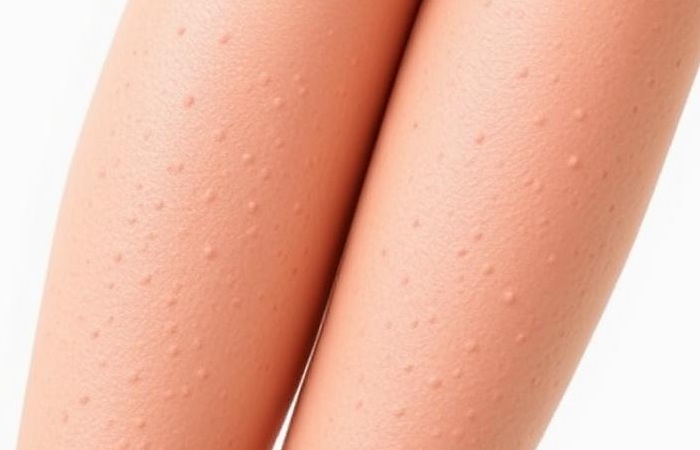You’re not alone if you noted little dark dots or pores on your legs that look like strawberry seeds. The good thing is that it can be treated and bearable to appreciate. Strawberry legs, as it is often referred to, can be pretty troublesome. This guide seeks to understand the causes of strawberry legs, how to prevent them, and the most effective ways to treat them.
Table of Contents
What Are Strawberry Legs?

Medically, it is known as keratosis pilaris or open comedones; strawberry legs result from clumping of the hair follicles or pores present on your legs with oil, dead skin cells , or bacteria. This creates dark dots that might make your skin appear nonuniform or lumpy. It isn’t dangerous, but lots of people long for ways to flatten and lighten their skin.
What Causes Strawberry Legs?

Understanding the root cause of strawberry legs is the first step to treating them. Common causes include:
- Blocked Pores: Too much oil and dead skin can stop hair follicles, leading to dark spots on the skin.
- Shaving: During dry shaving, people may neglect shaving cream and use a dull razor, causing irritation and swelling of the hair follicles.
- Dehydrated Skin: Dry skin often feels rough, making pores more noticeable and bumps more common.
- Genetics: Follicles of a specific type of skin have greater chances of collections of dirt in them, which is the blockage of the pore
- Folliculitis: Inflammation or infection of the hair follicles can cause something called strawberry legs.
- Ingrown Hair: The hair is grown inside the skin after shaving or waxing and causes skin inflammation.
- Keratosis Bumps are typically caused by a buildup of keratin on the skin, commonly known as keratosis pilaris.
How to Get Rid of Strawberry Legs: 7 Effective Tips
Here are some proven methods to help you achieve smoother, more apparent legs:
1. Exfoliate Regularly
Exfoliating helps get rid of dead skin, but it also helps unclog your pores. If a mild physical exfoliant is needed (for instance, sugar scrub), utilize it 2-3 times a week at the most. If a chemical exfoliant (salicylic or glycolic acid) is used, then 2-3 times weekly can be done. Cut back on frequency, as over-exfoliating can harm the skin.
2. Moisturize Daily
Consider looking for a hyper-comedogenic moisturizer that does not clog the pores of your skin. Such functionality will likely manifest with the help of ceramides, hyaluronic acid, or shea butter, all of which are remarkable skin moisturizers.
3. Upgrade Your Shaving Routine
- Always shave on wet skin with a fresh, clean razor.
- Use a shaving gel or cream to minimize friction.
- Also, shave in the direction your hair is growing to reduce irritation.
4. Try Hair Removal Alternatives
If shaving doesn’t improve your strawberry legs, you may want to try waxing, epilation, or laser hair removal as alternatives. These methods involve ripping hair out from the roots, which helps eliminate the risk of blocked pores.
5. Use Products with Salicylic Acid
Salicylic acid is a BHA, so it can enter the pores and break down oil and dead skin. Think about including a cleanser or toner with this acid in your skincare routine.
6. Apply Retinoids
Retinoids, which are related to vitamin A, can assist in unclogging pores and help with cell turnover. Because they can irritate, begin with a low concentration, and always use sunscreen during the day, as retinoids also heighten sun sensitivity.
7. Treat Folliculitis
It is advised to visit a skin doctor for folliculitis (which means infected hair follicles) to get topical antibacterial and antibiotic options for treatment.
How to Prevent Strawberry Legs?
Prevention is equally important as treatment. These tips will help you keep those legs smooth and blemish-free:
- Hydrate: Make sure to drink sufficient fluids for healthy skin.
- Wear Loose Clothing: Tight clothing can trap sweat and bacteria, clogging your pores.
- No Hot Showers: Hot water can wash away human oils, leading to dryness.
- Use Sunscreen: Apply sunscreen to the legs to protect from various UV rays, as its adverse effects can worsen pore conditions.
When to See a Dermatologist?
If strawberry legs don’t go away or any pain, swelling, or redness develops, it may be worth getting in touch with a dermatologist. Professional treatments, such as chemical peels or microdermabrasion, lasers, etc., can be pursued at this point.
Final Thoughts
Strawberry legs are a relatively common and treatable skin issue. For silkier, more translucent legs, establish a good skincare regimen, exfoliate regularly, and use the proper shaving techniques. Every person’s skin is unique, so uncovering what kinds of products work best for you might involve some trial and error.
With a bit of patience and the proper method, it is possible to leave behind strawberry legs and step into confident, glowing skin!
Disclaimer: Always patch-test new products, and consult a healthcare professional if you have sensitive skin or preexisting conditions.
